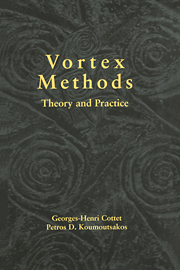Book contents
- Frontmatter
- Contents
- Preface
- 1 Definitions and Governing Equations
- 2 Vortex Methods for Two-Dimensional Flows
- 3 Three-Dimensional Vortex Methods for Inviscid Flows
- 4 Inviscid Boundary Conditions
- 5 Viscous Vortex Methods
- 6 Vorticity Boundary Conditions for the Navier–Stokes Equations
- 7 Lagrangian Grid Distortions: Problems and Solutions
- 8 Hybrid Methods
- Appendix A Mathematical Tools for the Numerical Analysis of Vortex Methods
- Appendix B Fast Multipole Methods for Three-Dimensional N-Body Problems
- Bibliography
- Index
Preface
Published online by Cambridge University Press: 21 September 2009
- Frontmatter
- Contents
- Preface
- 1 Definitions and Governing Equations
- 2 Vortex Methods for Two-Dimensional Flows
- 3 Three-Dimensional Vortex Methods for Inviscid Flows
- 4 Inviscid Boundary Conditions
- 5 Viscous Vortex Methods
- 6 Vorticity Boundary Conditions for the Navier–Stokes Equations
- 7 Lagrangian Grid Distortions: Problems and Solutions
- 8 Hybrid Methods
- Appendix A Mathematical Tools for the Numerical Analysis of Vortex Methods
- Appendix B Fast Multipole Methods for Three-Dimensional N-Body Problems
- Bibliography
- Index
Summary
The goal of this book is to present and analyze vortex methods as a tool for the direct numerical simulation of incompressible viscous flows. Its intended audience is scientists working in the areas of numerical analysis and fluid mechanics. Our hope is that this book may serve both communities as a reference monograph and as a textbook in a course of computational fluid dynamics in the schools of applied mathematics and engineering.
Vortex methods are based on the discretization of the vorticity field and the Lagrangian description of the governing equations that, when solved, determine the evolution of the computational elements. Classical vortex methods enjoy advantages such as the use of computational elements only in cases in which the vorticity field is nonzero, the automatic adaptivity of the computational elements, and the rigorous treatment of boundary conditions at infinity. Until recently, disadvantages such as the computational cost and the inability to treat accurately viscous effects had limited their application to modeling the evolution of the vorticity field of unsteady high Reynolds number flows with a few tens to a few thousands computational elements. These difficulties have been overcome with the advent of fast summation algorithms that have optimized the computational cost and recent developments in numerical analysis that allow for the accurate treatment of viscous effects. Vortex methods have reached today a level of maturity, offering an interesting alternative to finite-difference and spectral methods for high-resolution numerical solutions of the Navier–Stokes equations.
- Type
- Chapter
- Information
- Vortex MethodsTheory and Practice, pp. ix - xivPublisher: Cambridge University PressPrint publication year: 2000

